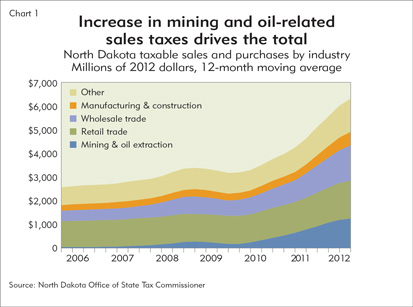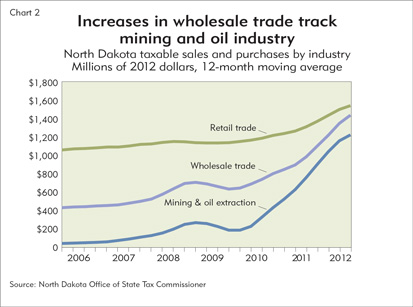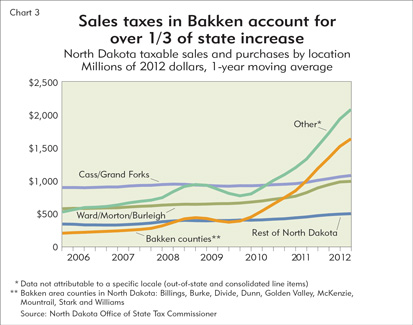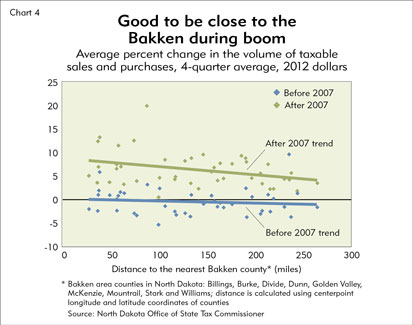Oil isn’t the only thing coming out of the ground in North Dakota’s oil patch. State sales taxes have also hit a gusher, due mostly to the increase in oil production in the Bakken formation in the western part of the state.
Over the past five years, the aggregate value of taxable sales and purchases in the state more than doubled (see Chart 1), averaging over 15 percent growth annually. In the decade preceding the boom, taxable sales averaged just over 2 percent growth annually. In the fiscal year ending in June 2012, taxable sales and purchases totaled $23.4 billion, raising $1.5 billion in sales tax collections.
The source of the state’s growth in sales taxes is not exactly a surprise, given the high-profile expansion of the state’s oil industry. But a look at taxable sales and purchases by industry and geography shows the full influence.
Over a third of the increase in overall taxable sales and purchases can be directly attributed to oil activity. Sales of drill bits, fracking chemicals, well casings, drilling mud and other inputs used in the production of oil and gas have experienced a 12-fold increase over the past five years (more than doubling every other year). The mining and oil industry now accounts for about 20 percent of total taxable sales and purchases in the state (excluding sales of oil and gas, which are subject to production taxes). In contrast, for most of the decade prior to 2007, the industry’s share barely ever rose above 1 percent of the total.
The other two-thirds of the increase in taxable sales and purchases appears to be largely spillovers from the oil boom. This is hard to prove, but correlations between taxable sales and purchases in mining and oil and other industry sectors were relatively weak before 2007, but very strong afterward. Collections from the wholesale trade sector have nearly tripled since 2007, but were more or less constant over the previous 10 years, hovering at around $450 million.
The oil boom has had a less dramatic effect on consumer spending. Retail sales historically account for half of taxable sales and purchases and have risen since 2007, but at a comparatively modest 5 percent annual growth rate (see Chart 2).
Impact of the Bakken
Since 2007, nine Bakken area counties have accounted for well over a third of the total increase in North Dakota sales taxes—this despite having just 11 percent of the state’s population. Sales taxes in the Bakken counties jumped in 2008 with the increase in oil drilling, subsided in 2009 when oil prices and drilling dipped and accelerated swiftly once oil drilling picked up again (see Chart 3). Sales to businesses that operate in multiple counties or out of state are not attributed to an individual county, and sales assigned to this “other” category account for 41 percent of the increase. It’s hard to say for certain that these businesses are oil-related, but the movement of this category closely follows that of Bakken counties.
Sales figures from the remainder of the state account for less than a quarter of the increase in total taxable sales and purchases. Ward, Burleigh and Morton counties encompass the cities of Minot, Bismarck and Mandan, gateway cities to the Bakken oil-drilling area. Sales taxes for these counties accelerated starting in 2011. Meanwhile, the state’s largest eastern counties (Cass and Grand Forks counties, home to Fargo and Grand Forks) show only a modest acceleration starting in 2011, similar to all remaining counties in North Dakota.
The Bakken influence can also be seen in terms of the distance of sales transactions from the oil-producing region. The farther a county is away from the Bakken, the slower is average growth in sales taxes (see Chart 4). Prior to 2007, this spatial relationship with the Bakken area was relatively weak.
The Bakken effect can also be seen among the state’s larger cities. Between 2010 and 2011, taxable sales and purchases in Dickinson and Williston (the two largest cities in the Bakken area) increased by over $1.4 billion (79 percent), of which $660 million came from growth in the mining and oil extraction industry and $280 million from growth in wholesale trade.
The fastest growing businesses in Williston and Dickinson were in transportation and warehousing, for which taxable sales and purchases increased by 197 percent in 2011. Among the four largest cities outside the Bakken (Bismarck, Minot, Grand Forks and Fargo), taxable sales and purchases in this category fell by 7.4 percent.










